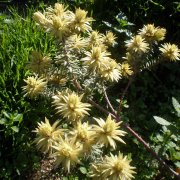Care of the shrub Phylica plumosa or Cape Myrtle |
|
The genus Phylica, family Rhamnaceae, comprises 150 species of evergreen shrubs native to southern Africa. Some species are: Phylica plumosa, Phylica ericoides, Phylica paniculata, Phylica arborea, Phylica vulgaris. Common names: Flannel Flower, Cape Myrtle, Flannel bush, Featherhead. This species is native to South Africa. They are erect evergreen shrubs that can reach 1 meter (3.28 feet) in height. They have interesting small, thin leaves, covered with hairs that reflect sunlight and give them a nice silver sheen. The curious and showy flowers are surrounded by hairy golden bracts and give off a slight smell of cinnamon. They produce fruits in the form of a brown capsule. Cape Myrtle is used in rockery, in bushy groups combined with Erica and Protea and in pots for terraces and balconies. It's ideal for Mediterranean coastal gardens. Phylica plumosa needs full sun exposure. It resists occasional frosts down to -6 ºC (21.2 ºF). Flannel Flower grows in any well-drained soil but prefers one that contains manure, coarse sand, and a little clay. Transplantation or planting is done in early spring. Water regularly with little water so that the substrate is slightly damp; Flannel bush resists several days of drought. Fertilize with compost, manure, or humus in late winter or early spring. Prune lightly in late spring to keep it compact. Phylica plumosa is a plant resistant to the usual pests but sensitive to excess humidity. Cape Myrtle is propagated from seeds collected from the same plant and sown in a seedbed in spring. |
Images of the shrub Phylica plumosa or Cape Myrtle |
Find plants
Phylica plumosa or Cape Myrtle | Care and Growing
© 2025 FavThemes

